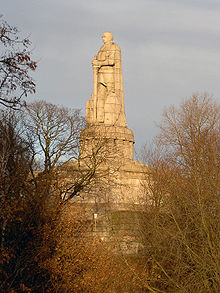Bismarck Monument (Hamburg)
Bismarck-Denkmal | |
 View of the monument from the southwest in 2004 | |
 | |
| 53°32′55″N 9°58′19″E / 53.54861°N 9.97194°E | |
| Location | Hamburg, Germany |
|---|---|
| Designer | Architect: Johann Emil Schaudt Sculptor: Hugo Lederer |
| Material | Granite |
| Height | 35 m (115 ft) |
| Opening date | 2 June 1906 |
| Dedicated to | Otto von Bismarck |
The Bismarck Monument (German: Bismarck-Denkmal) in Hamburg is a memorial sculpture located in the St. Pauli quarter dedicated to Otto von Bismarck. It is one of 250 memorials to Bismarck worldwide and is the largest and probably best-known of these Bismarck towers. The monument stands near the jetties of Hamburg port on the Elbhöhe, today a local recreation area. The architect was Johann Emil Schaudt; the sculptor was Hugo Lederer.
History
The site of the monument was previously occupied by the Elbpavillon restaurant which was removed in 1901. Mayor Johann Georg Mönckeberg established a citizens' commission to erect the monument at the site.
The Bismarck Monument cost 500,000 Goldmarks,[1] and construction finished in 1906.[2] The building of the monument was documented by the photographer Wilhelm Weimar, who worked for the Hamburg Museum für Kunst und Gewerbe.
Architecture
The monument is approximately 35 m (115 ft) high, weighs 600 t (590 long tons; 660 short tons), and is the world's largest Bismarck monument.[1][2]
Designers created a large network of catacombs beneath the monument. During the years 1939 to 1940, they became an air-raid shelter offering protection for up to 650 people.[2] The architect's intent for the catacombs remain unknown however they, and the entire monument interior, are no longer accessible for safety reasons. During the 1970s, a soldier who served with the British army during the occupation in Germany discovered a tunnel beneath the Bismarck memorial while in Hamburg which led to a Nazi hideout. He contacted the Daily Mirror newspaper and they contacted the Burgermeister in Hamburg. After viewing the tunnel as the soldier had just described it, the tunnel was sealed.[citation needed]
See also
References
- ^ a b Wiborg, Susanne (17 December 2008). "Der größte Bismarck der Welt" [The world's largest Bismarck]. Die Zeit (in German). Retrieved 2009-11-18.
- ^ a b c Hirschbiegel, Thomas (20 July 2006). "Der Titan vom Kiez wird 100" [The titan of the Kiez is 100]. Hamburger Morgenpost (in German). Archived from the original on 19 December 2010. Retrieved 15 January 2017.
Literature
- Jörg Schilling: Distanz halten - Das Hamburger Bismarckdenkmal und die Monumentalität der Moderne, Wallstein-Verlag, Göttingen 2006, ISBN 3-8353-0006-7
